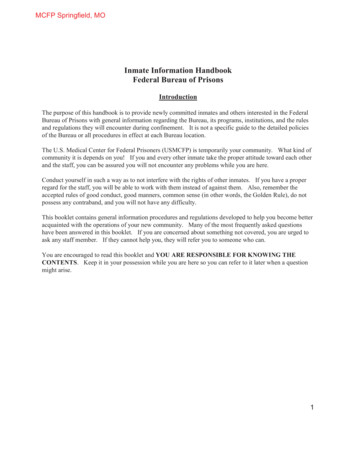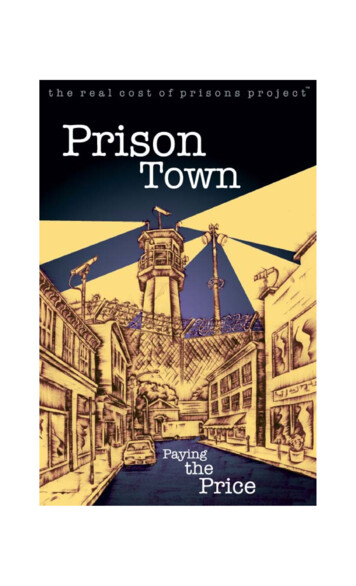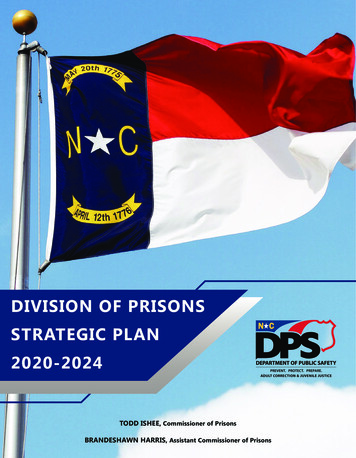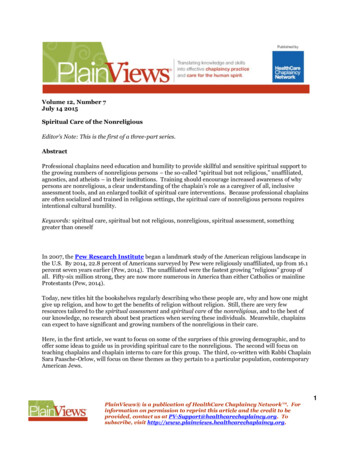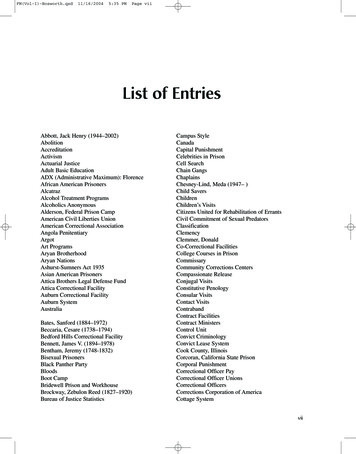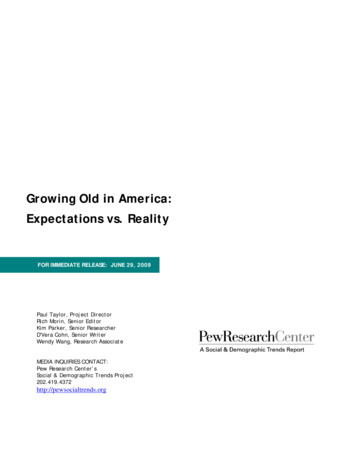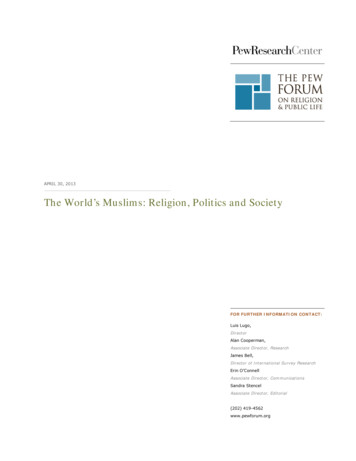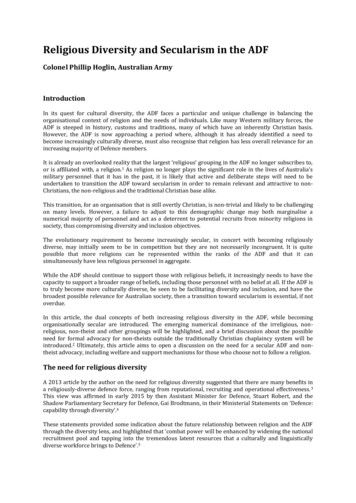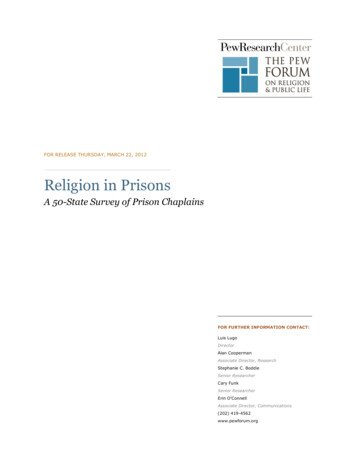
Transcription
FOR RELEASE THURSDAY, MARCH 22, 2012Religion in PrisonsA 50-State Survey of Prison ChaplainsFOR FURTHER INFORMATION CONTACT:Luis LugoDirectorAlan CoopermanAssociate Director, ResearchStephanie C. BoddieSenior ResearcherCary FunkSenior ResearcherErin O’ConnellAssociate Director, Communications(202) 419-4562www.pewforum.org
2Religion in Prisons: A 50-State Survey of Prison ChaplainsTHIS PAGE INTENTIONALLY BLANKwww.pewforum.org
3PEW FORUM ON RELIGION & PUBLIC LIFEAbout the Pew Forum on Religion & Public LifeThis report was produced by the Pew Research Center’s Forum on Religion & Public Life.The Pew Research Center is a nonpartisan fact tank that provides information on the issues,attitudes and trends shaping America and the world. The center conducts public opinionpolling, demographic studies, content analysis and other empirical social science research.It does not take positions on policy issues. The Pew Forum on Religion & Public Life is aproject of the Pew Research Center; it delivers timely, impartial information on the issues atthe intersection of religion and public affairs in the U.S. and around the world. The PewResearch Center is an independently operated subsidiary of The Pew Charitable Trusts.The report is a collaborative effort based on the input and analysis of the following individuals:Primary ResearchersStephanie C. Boddie, Senior Researcher, Pew Research Center’s Forum on Religion & Public LifeCary Funk, Senior Researcher, Pew Research Center’s Forum on Religion & Public LifePew ForumLuis Lugo, DirectorJoseph Liu, Web AssociateJillian Larson, Administrative CoordinatorResearchAlan Cooperman, Associate Director, ResearchPew Research CenterDavid Masci and Gregory A. Smith, Senior ResearchersAndrew Kohut, PresidentJessica Hamar Martinez, Besheer Mohamed,Paul Taylor, Executive Vice Presidentand Anne Shi, Research AssociatesElizabeth Mueller Gross, Vice PresidentElizabeth Lawton and Elizabeth Podrebarac,Scott Keeter, Director of Survey ResearchResearch AssistantsLeah Melani Christian, Senior ResearcherJessica Tennant, Informational Graphics DesignerEditorialSandra Stencel, Associate Director, EditorialVisit http://pewforum.org/Government/religion-in-Diana Yoo, Graphic Designerprisons.aspx to see the online version of the report.Tracy Miller, EditorHilary Ramp, Assistant EditorPew Research Center’sForum on Religion & Public LifeCommunications and Web Publishing1615 L St., NW, Suite 700Erin O’Connell, Associate Director, CommunicationsWashington, D.C. 20036-5610Stacy Rosenberg, Digital Project ManagerPhone (202) 419-4550Mary Schultz, Communications ManagerFax (202) 419-4559Liga Plaveniece and Jemila Woodson,www.pewforum.orgCommunications Associates 2012 Pew Research Centerwww.pewforum.org
THIS PAGE INTENTIONALLY BLANK
5PEW FORUM ON RELIGION & PUBLIC LIFETable of ContentsPAGEPreface7Executive Summary11I. Profile of State Prison Chaplains31II. What Prison Chaplains Do and What They Think They Should Do37III. The Role of Religious Volunteers43IV. Chaplains’ Perspectives on the Religious Lives of Inmates47V. Chaplains’ Views on the Correctional System61Appendix A: Survey Methodology69Appendix B: Topline73Appendix C: The State and Federal Correctional System99Appendix D: Glossary101Appendix E: External Advisers and Prison Chaplain Working Group105www.pewforum.org
6Religion in Prisons: A 50-State Survey of Prison ChaplainsTHIS PAGE INTENTIONALLY BLANKwww.pewforum.org
7PEW FORUM ON RELIGION & PUBLIC LIFEPrefaceReligion and religious people have always been a presence in American prisons. Indeed, someof the country’s first prisons were established at the urging of and with help from people offaith, who hoped that inmates could be reformed during their confinement.1Today, religious people still play an important role in the U.S. criminal justice system. Almostall of the nation’s more than 1,100 state and federal prisons have at least one paid chaplain orreligious services coordinator, and collectively they employ about 1,600 professionalchaplains.2These ministers, priests, imams, rabbis and religious lay people sit at the intersection of twosocial trends. The United States has the highest rate of incarceration in the developed world,with approximately 2.3 million men and women – or about 1-in-100 of the nation’s adults –behind bars.3 The U.S. also stands out among industrial democracies for its high levels ofreligious commitment, with about four-in-ten American adults saying they attend religiousservices weekly or more often, nearly six-in-ten saying that religion is very important in theirlives and more than nine-in-ten saying they believe in God or a higher power.4The constitutional right of Americans to the free exercise of religion – even if they are behindbars – has been affirmed by courts and bolstered by federal legislation, and the first duty ofprison chaplains is to help meet the religious needs of inmates. But, increasingly, chaplains areasked to do much more. In the face of studies suggesting that more than 40% of formerinmates end up back in prison within a few years, chaplains in many prisons are called upon tofight recidivism by counseling inmates and connecting them with religious organizations orother social service providers that can offer job training, substance abuse treatment, educationand other assistance before and after their release.51For an account of religion’s role in the early history of prisons in America, see Jennifer Graber, “The Furnace of Affliction: Prisonsand Religion in Antebellum America,” University of North Carolina Press, 2011.2In addition to state and federal prisons, the U.S. penal system also includes county and city jails that typically hold peopleawaiting trial and those sentenced for misdemeanors to terms of one year or less. For more details on the prison system, seeAppendix C.3As of 2010, one in every 104 U.S. adults was in the custody of state or federal prisons or local jails, according to the U.S.Department of Justice. See Lauren E. Glaze, “Correctional Population in the United States, 2010,” U.S. Department of Justice,Bureau of Justice Statistics, 2011, f. See also “One in 100: Behind Bars inAmerica 2008,” Pew Center on the States, Public Safety Performance Project, February 2008,http://www.pewcenteronthestates.org/report detail.aspx?id 35904.4For measures of religious commitment in the U.S., see “U.S. Religious Landscape Survey,” Pew Research Center’s Forum onReligion & Public Life, 2007, http://religions.pewforum.org/reports. For measures of religious commitment in other countries, see“Unfavorable Views of Jews and Muslims on the Increase in Europe,” Pew Research Center’s Global Attitudes Project, rope/.5See “State of Recidivism: The Revolving Door of America’s Prisons,” Pew Center on the States, Public Safety PerformanceProject, 2011, http://www.pewcenteronthestates.org/report detail.aspx?id 85899358613.www.pewforum.org
8Religion in Prisons: A 50-State Survey of Prison ChaplainsIn light of public concern about religious terrorism since the 9/11 attacks, chaplains also aresometimes viewed as a first line of defense against the spread of religious extremism. Whilethey work to provide compassionate care to individual inmates, chaplains are charged withassisting wardens and other correctional officials to maintain the safety and security of theprisons where they work. Indeed, chaplains often are considered part of a prison’smanagement team.Moreover, the role of chaplains continues to be recast to suit the changing needs of thecorrectional system. For instance, recent research suggests that, due to a shortage of fundingand staff, many chaplains have shifted their focus from direct ministry to administrativeduties, such as recruiting and supervising community volunteers, processing inmate requestsfor special diets and other religious accommodations, and organizing secular as well asreligious programs to counsel, mentor and educate inmates.6For all these reasons, the Pew Research Center’s Forum on Religion & Public Life decided toconduct a large-scale survey of professional prison chaplains across the United States. Wereceived generous financial support for this endeavor from the Annie E. Casey Foundation aswell as from The Pew Charitable Trusts. With the endorsement of the American CorrectionalChaplains Association and months of unrelenting effort, Pew Forum Senior ResearcherStephanie C. Boddie obtained approval from correctional authorities in all 50 states to surveythe more than 1,400 state prison chaplains.With the encouragement of present and former prison officials, we also sought permission toinclude federal prison chaplains in the survey. Unfortunately, the Federal Bureau of Prisonsdecided not to allow its approximately 200 chaplains to participate.Part of the impetus for the survey is that little data have been available to the public on the roleof religion in state prisons.7 State and federal correctional authorities routinely reportinformation on the age, sex and race/ethnic origin of prisoners, as well as the types of offensesfor which they are incarcerated. And, according to the chaplains surveyed, many prisons alsokeep track of the religious preferences of inmates, as well as of religious switching. But thosedata are seldom or never made public.6See Richard Denis Shaw, “Chaplains to the Imprisoned: Sharing Life With the Incarcerated,” Haworth Press, 1995, and Jody L.Sundt, Harry R. Dammer and Francis T. Cullen, “The Role of the Prison Chaplain in Rehabilitation,” Journal of OffenderRehabilitation, Volume 35, Issue 3/4, pages 59-86, 2002.7Some data on the religious affiliation of inmates in federal prisons and selected state prisons as of 2007 are available from theUnited States Commission on Civil Rights. See “Enforcing Religious Freedom in Prison,” United States Commission on Civil Rights,2008, wforum.org
9PEW FORUM ON RELIGION & PUBLIC LIFEAs a result, “Religion in Prisons: A 50-State Survey of Prison Chaplains” presents a rarewindow into religion behind bars. Although chaplains, like all observers, undoubtedly bringtheir own perspectives and predilections to bear, they also occupy a valuable vantage point ascorrectional workers who have regular, often positive interactions with inmates and take astrong interest in the role of religion in inmates’ lives.The survey covers a lot of ground, asking chaplains to describe their daily role in the prisonsand to rate their job satisfaction. In addition, we asked them to list the tasks on which theyspend the most time and the tasks they consider most important – two lists that are not alwaysthe same. We sought their assessments of religious volunteers who come into the prisons towork with inmates, as well as their perspectives on the strengths and weaknesses of thecorrectional system, the quality and reach of rehabilitation programs and possible ways ofcutting costs.We also asked for their impressions about religious life in prisons, including the religiouscomposition of the inmate population, the amount of proselytizing and conversion that takeplace, which religious groups seem to be growing or shrinking, and how much religiousextremism they perceive in the prisons where they work. At several key points in the surveyquestionnaire – which was administered either electronically or, for those who preferred it, bypaper – we gave the chaplains an opportunity to elaborate on their views and experiences intheir own words.Their answers suggest that religion in prisons may be quite different, in some ways, fromreligion in American society at large. For example, chaplains indicate that there is a visiblepresence in some prisons of small religious groups that many Americans may never have heardof, such as Asatru, Odinism and the Moorish Science Temple of America. (For brief definitions,see the Glossary on page 101.) A number of chaplains also think that some inmates claim tobelong to particular religious groups solely to obtain privileges or benefits, such as kosher food.But, on the whole, chaplains had many positive things to say about the role of religion inrehabilitating inmates. Most are also very happy in their jobs. Though the picture that emergesis complicated and sometimes surprising, our hope is that the survey will contribute to a betterunderstanding of the role that chaplains – and, more broadly, religion – play in the lives ofinmates.www.pewforum.org
10Religion in Prisons: A 50-State Survey of Prison ChaplainsAcknowledgmentsIn preparing this survey, the Pew Forum received invaluable advice from a number of eminentscholars and experts in the criminal corrections field. They include Todd Clear, dean ofRutgers School of Criminal Justice; John DiIulio, the Frederic Fox Leadership Professor ofPolitics, Religion, and Civil Society at the University of Pennsylvania; Catherine A. Gallagher,associate professor in Criminology, Law and Society at George Mason University; TomO’Connor, CEO of Transforming Corrections and former research manager for the OregonDepartment of Corrections; Jody Sundt, assistant professor and graduate coordinator in theDivision of Criminology and Criminal Justice at Portland State University; Farid Senzai, fellowand director of research at the Institute for Social Policy and Understanding; and Sister SusanVan Baalen, former chief chaplain at the Federal Bureau of Prisons. Several other scholarsgenerously provided feedback and assistance at various stages in the conceptualization of theproject. A complete list of advisers can be found in Appendix E on page 105.As previously noted, the survey received a very helpful endorsement from the AmericanCorrectional Chaplains Association (ACCA). We would like to thank its leadership team,particularly Anthony J. Bruno, current chancellor and past president of the ACCA and directorof religious services at the Connecticut Department of Correction; Dale Hale, president of theACCA and Salvation Army major; Gary Friedman, communications chairman for the ACCAand chairman of Jewish Prisoner Services International; and Stephen Hall, first vice presidentof the ACCA and director of religious and volunteer services at the Indiana Department ofCorrection.Also as previously noted, the survey received substantial funding from the Annie E. CaseyFoundation, where Carole E. Thompson was an unstinting – and patient – supporter of thiseffort.Fieldwork for the survey was carried out by Social Science Research Solutions (SSRS) and verycompetently led by Robyn Rapoport and Linda Lomelino. While the survey design was guidedby our advisers, contractors and consultants, the Pew Forum is solely responsible for theinterpretation and reporting of the data.Luis Lugo, DirectorAlan Cooperman, Associate Director, Researchwww.pewforum.org
11PEW FORUM ON RELIGION & PUBLIC LIFEExecutive SummaryFrom the perspective of the nation’s professional prison chaplains, America’s statepenitentiaries are a bustle of religious activity. More than seven-in-ten (73%) state prisonchaplains say that efforts by inmates to proselytize or convert other inmates are either verycommon (31%) or somewhat common (43%). About three-quarters of the chaplains say that alot (26%) or some (51%) religious switching occurs among inmates in the prisons where theywork. Many chaplains report growth from religious switching in the numbers of Muslims andProtestant Christians, in particular.Overwhelmingly, state prison chaplains consider religious counseling and other religion-basedprogramming an important aspect of rehabilitating prisoners. Nearly three-quarters of thechaplains (73%), for example, say they consider access to religion-related programs in prisonto be “absolutely critical” to successful rehabilitation of inmates. And 78% say they considersupport from religious groups after inmates are released from prison to be absolutely critical toinmates’ successful rehabilitation and re-entry into society. Among chaplains working inprisons that have religion-related rehabilitation or re-entry programs, more than half (57%)say the quality of such programs has improved over the last three years and six-in-ten (61%)say participation in such programs has gone up.At the same time, a sizable minority of chaplains say that religious extremism is either verycommon (12%) or somewhat common (29%) among inmates. Religious extremism is reportedby the chaplains as especially common among Muslim inmates (including followers of theNation of Islam and the Moorish Science Temple of America) and, to a substantial but lesserdegree, among followers of pagan or earth-based religions such as Odinism and various formsof Wicca. (See Glossary on page 101.) An overwhelming majority of chaplains, however, reportthat religious extremism seldom poses a threat to the security of the facility in which theywork, with only 4% of chaplains saying religious extremism among inmates “almost always”poses a threat to prison security and an additional 19% saying it “sometimes” poses a threat.These are among the key findings of a survey of prison chaplains in all 50 states by the PewResearch Center’s Forum on Religion & Public Life. The survey was conducted from Sept. 21 toDec. 23, 2011, using Web and paper questionnaires. The Pew Forum attempted to contact all1,474 professional chaplains working in state prisons across the country, and 730 chaplainsreturned completed questionnaires, a response rate of nearly 50%.www.pewforum.org
12Religion in Prisons: A 50-State Survey of Prison ChaplainsLittle information is publicly available about the religious lives of the approximately 1.6 millioninmates in the U.S. prison system, the vast majority of whom (87%) are under the jurisdictionof state correctional authorities.8 The U.S. Bureau of Justice Statistics routinely reports onseveral characteristics of the U.S. prison population, such as age, gender and racial/ethniccomposition, but it does not usually report on the religious affiliation of inmates, andindependent surveys of inmates rarely are permitted.9 Thus, the Pew Forum survey offers arare window into the religious lives of inmates through the lens of prison chaplains.In assessing that lens, it may be helpful to know some characteristics of the chaplains whoresponded to the survey. They are predominately male (85%), middle-aged (57 years old, onaverage), white (70%), Christian (85%, including a 44% plurality who are evangelicalProtestants) and highly educated (62% with graduate degrees). They describe themselves asconservative on both social issues (53%) and political issues (55%). Most report having a lot ofdirect contact with inmates: Fully 90% say they have one-on-one contact with at least a quarterof all the inmates in the facility where they work, and two-thirds (66%) say that “personallyleading worship services, religious instruction sessions or spiritual counseling sessions” isamong the top three activities on which they spend the most time. About half have been on thejob for more than a decade, and most report high job satisfaction.8For more details, see Appendix C: The State and Federal Correctional System on page 99.Prisoners are rarely allowed to participate in research studies of any kind, partly because of prior abuses of their involuntaryavailability for such studies. To be permitted, studies usually must demonstrate a clear cost-benefit calculation in the prisoners’favor, such as the benefit from receiving a specific medical treatment. The possible “psychic rewards” to inmates of being able toexpress their opinions and describe their experiences on a survey questionnaire, or the value of the information to the public,generally are not considered sufficient by correctional authorities to justify a survey of inmates.9www.pewforum.org
13PEW FORUM ON RELIGION & PUBLIC LIFERehabilitation, Re-entry and ReligionMost chaplains are upbeat about the prisons where they work. About six-in-ten (61%) of thosesurveyed say their state’s correctional system “works pretty well” and needs only minorchanges, while a third (34%) say the systemneeds major changes and 5% say it needs to beUsage of Rehab Programscompletely re-built.Asked to rate specific aspects of the system’sperformance, chaplains are most positiveabout the maintenance of discipline. Nine outof 10 chaplains surveyed say the statecorrectional system where they work doeseither an excellent job (40%) or a good job(54%) of maintaining order and discipline inprisons. But they are less sanguine aboutefforts to rehabilitate inmates and preparethem for re-entry into the community. Only 8%say the system where they work is doing anexcellent job of preparing inmates forreintegration into the community, while 37%say it is doing a good job and a majority say thesystem is only fair (37%) or poor (17%) atreadying inmates to return to the wider society.Among those who work in prisons with rehabilitationand re-entry programs, % who say participationover past three years has Gone upStayed same61Gone down316Q12 Based on those with a religion-related rehabilitation andre-entry program in the prison where they work, N 449.No answer responses not shown.PEW RESEARCH CENTER’SFORUM ON RELIGION & PUBLIC LIFEQuality of Rehab ProgramsAmong those who work in prisons with rehabilitationand re-entry programs, % who say program qualitytoday compared with past three years is BetterSameWorse57367There is strong consensus among the chaplainssurveyed about several elements that areQ11 Based on those with a religion-related rehabilitation andre-entry program in the prison where they work, N 449.important for successful rehabilitation andNo answer responses not shown.reintegration into society. These includePEW RESEARCH CENTER’SFORUM ON RELIGION & PUBLIC LIFEservices provided while in prison as well assupport upon release. And, perhaps notsurprisingly, chaplains put access to religion-related programs in this mix. More than sevenin-ten chaplains (73%) consider access to high-quality religion-related programs in prison tobe “absolutely critical” for successful rehabilitation and re-entry, and an additional 23% saysuch programs are very important, though not critical.About six-in-ten chaplains (62%) say that religion-related programs for rehabilitation and reentry (such as faith-based job training or mentoring programs) are available in the prisonswww.pewforum.org
14Religion in Prisons: A 50-State Survey of Prison Chaplainswhere they work. Most of these chaplains consider the religion-related programs to be thrivingboth in terms of usage and quality.Among those working in a prison with a religion-related rehabilitation program, about six-inten (61%) say usage has increased over the past three years, 31% say usage has stayed the sameand just 6% say usage has gone down. A majority of those working in a prison with a programof this sort also say that the quality of the religion-related rehabilitation programs hasimproved (57%), while 36% say the quality is about the same and 7% say the program’s qualityhas declined over the past three years.www.pewforum.org
15PEW FORUM ON RELIGION & PUBLIC LIFEReligious ExtremismSince the 9/11 terrorist attacks, religiousextremism has been a topic of high publicinterest in the United States. Some expertsspecifically have raised concerns that prisonscould be a breeding ground for home-grownterrorists and have suggested that prisonchaplains and other prison administratorsneed to monitor religious activity moreclosely.10 The Pew Forum survey devotesseveral questions to the topic of religiousextremism, probing the extent to which prisonchaplains perceive it to be common and askingthem to describe the kinds of extreme religiousviews they encounter behind bars.A majority (58%) of state prison chaplainssurveyed say that religious extremism is eithernot too common (42%) or not at all common(16%) in the facilities where they work, while12% say that it is very common and 29% say itis somewhat common. At the same time, aboutthree-quarters of the chaplains say thatreligious extremism poses a threat to thesecurity of the facility either “not too often”(26%) or “rarely or almost never” (50%).A number of factors are likely to influencechaplains’ perceptions of religious extremism,of course, including the experiences of theHow Common is ReligiousExtremism in Prisons?% saying extreme religious views among inmatesare Very common12Somewhat29Not too/not at all58Q30a. Those not answering are not shown. Figures forcombined categories may not sum from their componentparts due to rounding.PEW RESEARCH CENTER’S FORUM ON RELIGION & PUBLICLIFEHow Often Does ReligiousExtremism Among Inmates Pose aSecurity Threat?% of chaplains saying extremism poses a threat inthe prisons where they work Almost alwaysSometimesNot too often/rarely or almost never41976Q32. Those not answering are not shown. Figures forcombined categories may not sum from their componentparts due to rounding.PEW RESEARCH CENTER’S FORUM ON RELIGION & PUBLICLIFE10A 2010 article in the FBI Law Enforcement Bulletin, for example, argued that “Prisons literally provide a captive audience ofdisaffected young men easily influenced by charismatic extremist leaders” and that “The shortage of qualified religious providersin prisons heightens the threat of inmate radicalization.” See Dennis A. Ballas, “Prisoner Radicalization,” FBI Law EnforcementBulletin, October 2010, nce-and-market-positioning.www.pewforum.org
16Religion in Prisons: A 50-State Survey of Prison Chaplainschaplains in the facility where they work as well as their individual background andperspectives. For example, estimates of how common extreme religious views are tend to varywith the security level of the facility where chaplains work. About four-in-ten chaplains inmaximum security (44%) and medium security facilities (42%) say religious extremism is veryor somewhat common, compared with 32% among chaplains in minimum security facilitiessaying the same.Views on the prevalence of religious extremismamong inmates also tend to vary with thereligious affiliation and race of the chaplains.Protestant chaplains are more likely than thoseof the Catholic or Muslim faith to say thatreligious extremism in the prisons is eithervery or somewhat common. This tendency is abit stronger among white evangelical chaplainsthan it is among white mainline Protestants.How Common Are ExtremeReligious Views (by Chaplains’Religion)?% saying that encountering religious groups thatexpress extreme religious views is Very/Not too/someNotwhatat allNocommon common answerChaplainswho are %%%Protestant43561 100N519Analysis of these differences is constrained byWhiteevangelical4455* 100 264the modest number of chaplains from some ofWhitethese faith traditions who are in the survey.mainline34651 10094For example, 98 respondents are Catholic, andBlackProtestant39601 10095only 53 are Muslim. However, those who areCatholic32680 10098Muslim appear less likely than other chaplainsMuslim23752 10053to perceive a lot of religious extremism amongQ30a. Figures may not sum to 100%, and combinedcategories may not sum from their component parts,inmates. Just 23% of the Muslim chaplains saydue to rounding.religious extremism is either very common orPEW RESEARCH CENTER’S FORUM ON RELIGION & PUBLIC LIFEsomewhat common in the prisons where theywork, while 43% of Protestant chaplains takethat view. Catholic chaplains fall in between, with 32% saying religious extremism is very orsomewhat common in the facilities where they work.www.pewforum.org
17PEW FORUM ON RELIGION & PUBLIC LIFEThe Pew Forum survey also asked chaplains to rate the prevalence of extremist views amonginmates in each of 12 religious groups. (The chaplains were given the option of indicating thatthe facility in which they work has no inmates belonging to a particular faith. The figuresshown here are based on those providing a response.) A majority of respondents to thisquestion say that religiousextremism is either veryHow Common Is Religious Extremism?common (22%) or somewhatcommon (36%) amongMuslim inmates (includingfollowers of the Nation ofIslam and the MoorishScience Temple of America).A sizable minority of thechaplains responding (39%)also say they encounterextremism among inmateswho practice pagan or earthbased religions. Of thoseanswering this question,about six-in-ten (61%) seesuch views as not toocommon or not at allcommon among paganinmates.% rating religious extremism among inmates of each religious group as Very/somewhat commonNot too/not at all commonMuslims 57Pagan/earth-based4339Protestants612476Other non-Christian 2179Native Am. 92Mormons892Orthodox Christians 694Buddhists793Hindus 694Religious extremism isperceived as less prevalentQ31a-l. Based on all answering. Those who responded that no inmates belong to theamong other groups ofgroup or did not give an answer are excluded. Figures may not sum to 100%, andcombined categories may not sum from their component parts, due to rounding.inmates. About a quarter Includes followers of the Nation of Islam and the Moorish Science Temple ofAmerica.(24%) of chaplains The question listed the following examples: “Baha’is, Rastafarians, practitionersresponding to this questionof Santeria, Sikhs and others.”say that religious extremismPEW RESEARCH CENTER’S FORUM ON RELIGION & PUBLIC LIFEis very or somewhat commonamong Protestant inmates;76% say extremism is not too or not at all common among Protestants in the prisons wherethey work.www.pewforum.org
18Religion in Prisons: A 50-State Survey of Prison ChaplainsAbout a fifth of chaplains say extremism is very or somewh
Preface 7 Executive Summary 11 I. Profile of State Prison Chaplains 31 II. What Prison Chaplains Do and What They Think They Should Do 37 III. The Role of Religious Volunteers 43 IV. Chaplains' Perspectives on the Religious Lives of Inmates 47 V. Chaplains' Views on the Correctional System 61 Appendix A: Survey Methodology 69

